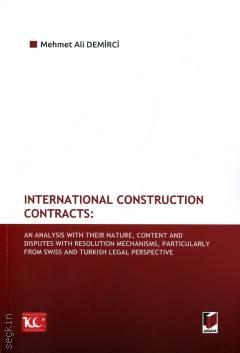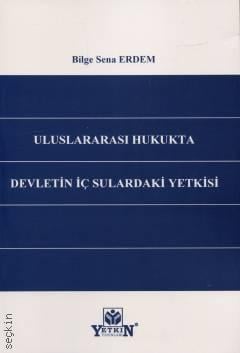
International Construction Contracts
An Analysis of Their Nature, Content and Disputes With Resolution Mechanisms, Particularly From Swiss and Turkish Legal Perspective
1. Baskı,
Kasım 2023
Kitabın Detayları
Dili:
Türkçe
Ebat:
16x24
Sayfa Sayısı:
133
Kitabın Fiyatı:
360,00₺
Temin süresi 2-3 gündür.
Kitabın Açıklaması
International construction contracts are a multidisciplinary type of contract, they are often seen as contracts where technical disciplines are prioritized and technical details are addressed. However, exceptional events such as today's pandemic, inflation, war and the existence of a wide variety of interfaces show us that the legal dimension of these contracts must be addressed as well as the technical ones. Therefore, International construction contracts were discussed with a holistic approach, including the spirit of the contracts, possible disputes and resolution methods. While doing that, I aimed to present an up-to-date study by frequently referring to the 2017 version of FIDIC, which could be called the lex mercatoria of construction contracts.
In addition to that, while dealing with Construction Contracts from a legal perspective, I preferred to focus on the content and spirit of these contracts instead of focusing on the dispute, as would expected from a lawyer. As a matter of fact, most of the time, disputes arise from a deficiency in the preparation phase of the contract and the failure to grasp the essence of the contract. The purpose of trying to draw the legal picture of construction contracts throughout the study is to underline that the preventive legal approach and reconciliation culture are indispensable for these contracts.
As the last word, even the possibility of contributing to this field, where Turkish Legal Literature is relatively untouched, makes me feel honored.
Kitapla İlgili Kategoriler
Kitabın İçindekileri
TABLE OF CONTENTS
FOREWORD
7
ÖZET
9
ABSTRACT
11
TABLE OF CONTENTS
13
ABBREVIATIONS
19
CHAPTER ONE
THE NATURE OF CONSTRUCTION CONTRACTS
1. Exclusive Structure of Construction Projects
23
2. Particularities of Construction Contracts
24
2.1. Custom–Made Projects
24
2.2. Duration
25
2.3. Complexity
26
2.4. Construction Site
27
2.5. Financial Dimension
27
2.6. International Scope
29
2.7. Voluminous Documentation
30
2.7.1. Plant Deion/Specification
31
2.7.2. Design
31
2.7.3. Bill of Quantities (BoQ)
32
2.7.4. Contract Price
34
2.7.5. Payment Schedule / Milestones
34
2.7.6. Others
35
2.8. Need for Flexibility and Reformation
35
3. Parties of a Construction Project
36
3.1. Employer (Owner–Client–Customer)
36
3.2. Contractor(Entrepreneur)
37
3.3. Subcontractor(s)
38
3.4. Engineer / Architect
39
3.5. Quantity Surveyor (Cost Consultant/Engineer)
40
3.6. Others
40
4. Obligations of Parties
41
4.1. Contractor’s Obligations
41
4.1.1. Execution of the Work
41
4.1.2. Duty to Inform
42
4.1.3. Delivery of the Work
43
4.1.4. Statutory Obligations
44
4.2. Employer’s Obligations
44
4.2.1. Payment of the Contract Price
44
4.2.1.1. Fixed Price / Lump Sum:
44
4.2.1.2. Unit Price / Re–Measurement:
45
4.2.1.3. Cost–Reimbursement / Cost–Plus:
46
4.2.2. Non–Hindrance and Collaboration
46
4.2.3. Duty of Notice for Defects
47
5. Types of Construction Contracts
48
5.1. Build–OnlyDesign–Bid–Build
48
5.2. Turn–KeyDesign and Build (DB)
49
5.3. Engineering, Procurement, and Construction (EPC)
50
5.4. Build, Operate, and Transfer (BOT)
51
5.5. Construction Management (CM)
51
6. Place in Swiss and Turkish Legal System
52
7. The Integral Part of Construction Contracts: Standard Rules
57
7.1. FIDIC
58
7.1.1. FIDIC Red Book
60
7.1.2. FIDIC Yellow Book
61
7.1.3. FIDIC Silver Book
62
7.2. NEC
62
7.3. JCT
63
CHAPTER TWO
POTENTIAL DISPUTES AND FORCE MAJEURE & HARDSHIP
1. Variations / Changes
65
1.1. Possible Variation Cases
65
1.2. The Scope of Variations
66
1.3. The Role of Engineer in Variations
68
1.4. Valuation Matter
69
2. Defects
70
2.1. Before Taking Over
71
2.2. After Taking Over
72
2.2.1. Defects Notification Period (DNP)
72
2.2.2. Remedies Against Defects
73
2.3. Serial Defects
74
2.4. Performance Certificate
74
3. Delays
75
3.1. Types of Delays
78
3.1.1. Critical / Non–Critical Delays
78
3.1.2. Excusable / Non–Excusable Delays
79
3.1.2.1. Compensable / Non–Compensable Delays:
80
3.1.3. Concurrent Delays
80
3.2. The Completion Date
83
3.3. Extension of Time (EoT)
84
3.4. Entitlement to Additional Expenses and Loss
86
3.5. Liquidated Damages (LDs)
87
4. Force Majeure
89
4.1. Differences Arising From Impossibility Types
92
4.2. Perspective of FIDIC
93
4.2.1. Consequences of Exceptional Events
95
5. Hardship
96
6. Force Majeure and Hardship Scenarios With Current Issues Through The
Example of A NPP Project in Turkey
98
6.1. COVID–19
99
6.2. Climate Chance
100
6.3. Sanctions and Embargos
103
6.4. InflationFluctuations
104
7. Termination
105
7.1. Employer’s Termination
106
7.2. Contractor’s Termination and Suspension
108
CHAPTER THREE
DISPUTES RESOLUTION METHODS AND MULTI–TIER CLAUSES
1. Conciliation and Mediation
110
2. Dispute Boards
112
2.1. FIDIC DAAB
113
3. Arbitration
114
3.1. Features and Advantages
115
3.2. Drawbacks
116
3.3. Ad Hoc vs Institutional Arbitration
118
4. Multi–Tier Clauses
119
CONCLUSION
123
BIBLIOGRAPHY
127
Kitabın Fiyatı:
360,00₺
Temin süresi 2-3 gündür.
Hakkımızda
|
Uluslararası Yayınevi Belgesi|
Kaynakça Dosyası|
Kişisel Verilerin Korunması |
Üyelik|
Siparişlerim|
İade Politikası|
İletişim


